五年级英语第六单元
- 格式:doc
- 大小:146.01 KB
- 文档页数:24
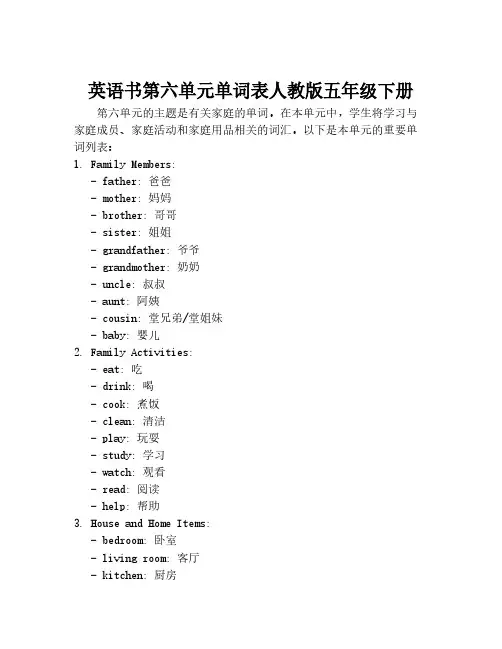
英语书第六单元单词表人教版五年级下册第六单元的主题是有关家庭的单词。
在本单元中,学生将学习与家庭成员、家庭活动和家庭用品相关的词汇。
以下是本单元的重要单词列表:1. Family Members:- father: 爸爸- mother: 妈妈- brother: 哥哥- sister: 姐姐- grandfather: 爷爷- grandmother: 奶奶- uncle: 叔叔- aunt: 阿姨- cousin: 堂兄弟/堂姐妹- baby: 婴儿2. Family Activities:- eat: 吃- drink: 喝- cook: 煮饭- clean: 清洁- play: 玩耍- study: 学习- watch: 观看- read: 阅读- help: 帮助3. House and Home Items:- bedroom: 卧室- living room: 客厅- kitchen: 厨房- bathroom: 浴室- dining room: 餐厅- sofa: 沙发- table: 桌子- chair: 椅子- bed: 床- television: 电视通过学习以上单词,学生能够了解关于家庭的不同成员和他们的活动。
这些词汇将为学生构建有关家庭的基础知识,并帮助他们形成综合的英语交流能力。
在学习这些单词时,可以采用多种教学方法来帮助学生记忆和理解。
首先,可以使用图片和图表来引导学生识记和记忆每个单词。
让学生观察图片并与相应的英语单词联系起来,这有助于他们建立单词和实际对象之间的联系。
其次,可以通过角色扮演和小组活动来扩展学生的英语口语能力。
例如,在家庭成员的角色扮演中,让学生用单词表达他们在家中的不同身份和活动。
通过这样的练习,学生能够更好地理解和运用这些词汇。
此外,可以结合听力和阅读材料来帮助学生巩固他们的词汇知识。
通过听力训练和阅读练习,学生可以更好地理解和熟练运用这些词汇,提高他们的听力和阅读技能。
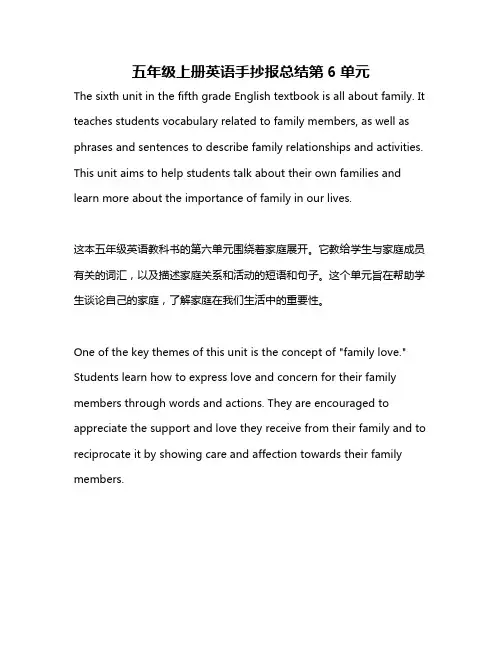
五年级上册英语手抄报总结第6单元The sixth unit in the fifth grade English textbook is all about family. It teaches students vocabulary related to family members, as well as phrases and sentences to describe family relationships and activities. This unit aims to help students talk about their own families and learn more about the importance of family in our lives.这本五年级英语教科书的第六单元围绕着家庭展开。
它教给学生与家庭成员有关的词汇,以及描述家庭关系和活动的短语和句子。
这个单元旨在帮助学生谈论自己的家庭,了解家庭在我们生活中的重要性。
One of the key themes of this unit is the concept of "family love." Students learn how to express love and concern for their family members through words and actions. They are encouraged to appreciate the support and love they receive from their family and to reciprocate it by showing care and affection towards their family members.这个单元的一个关键主题是“家庭的爱”。
学生学会如何通过言行来表达对家庭成员的爱和关心。
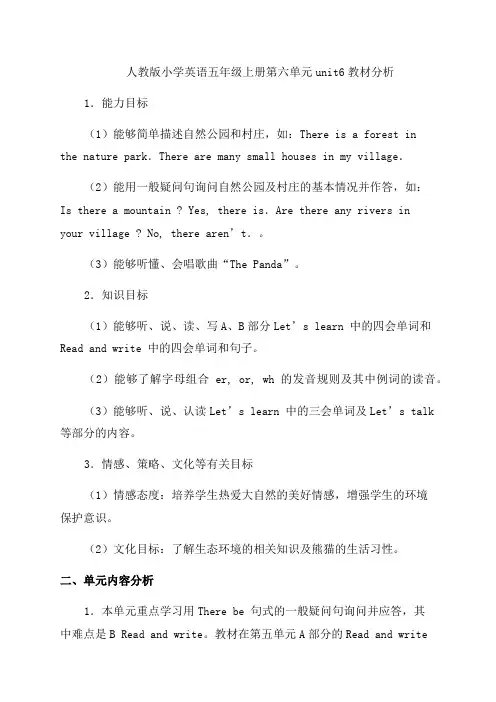
人教版小学英语五年级上册第六单元unit6教材分析1.能力目标(1)能够简单描述自然公园和村庄,如:There is a forest inthe nature park.There are many small houses in my village.(2)能用一般疑问句询问自然公园及村庄的基本情况并作答,如:Is there a mountain ? Yes, there is.Are there any rivers inyour village ? No, there aren’t.。
(3)能够听懂、会唱歌曲“The Panda”。
2.知识目标(1)能够听、说、读、写A、B部分Let’s learn 中的四会单词和Read and write 中的四会单词和句子。
(2)能够了解字母组合er, or, wh 的发音规则及其中例词的读音。
(3)能够听、说、认读Let’s learn 中的三会单词及Let’s talk 等部分的内容。
3.情感、策略、文化等有关目标(1)情感态度:培养学生热爱大自然的美好情感,增强学生的环境保护意识。
(2)文化目标:了解生态环境的相关知识及熊猫的生活习性。
二、单元内容分析1.本单元重点学习用There be 句式的一般疑问句询问并应答,其中难点是B Read and write。
教材在第五单元A部分的Read and write以及本单元A Read and write、B Let’s talk中都做了铺垫,教师在教学过程中要注意运用这些铺垫,减轻教与学的难度。
2.另外,本单元There be 句型一般疑问句中any一词的用法及字母组合er, or, wh的发音规则比较难以掌握,教师在教学中要予以特别关注。
三、单元教与学建议第一课时1.能够听、说、读、写本课时主要单词:flower, grass, river, lake, forest, path。
2.能够听、说、认读单词:sky, cloud, mountain及句子:There is a forest in the nature park.3.能够完成Let’s find out 中找图片区别的任务。

小学英语单元作业设计一、单元信息二、单元分析本单元学习主题是自然公园。
通过展示Miss White带领学生在自然公园游玩的情景呈现。
核心句型是Is there a river in the forest,Miss White?Yes,there is./No,there isn't.Are there any tall buildings in the nature park?Yes,there are./No,there aren't.通过Miss White带领学生去森林游远的情景呈现。
学习单词:forest,lake,mountain,hill,river。
通过John和陈杰谈论自然公园地图的情景呈现。
通过张鹏和Miss White 在自然公园里的餐馆就餐的情景感知。
学习单词:house,tree,bridge,building,village。
通过Miss White和学生游览自然公园的情景呈现。
故事板块呈现的是Zoom和Zip去公园游玩拍照的故事,理解新词koala和新句子:What a nice day!There is so much corn!Why don't you take apicture of me?Later,Zoom.Your card is broken!三、单元学习与作业目标能听、说、读、写句型:Is there a river in the forest? Yes,there is./No,there isn't. Are there any tall buildings in the nature park? Yes,there are./No,there aren 't.能运用句型Is there…?Yes,there is. / No,there isn't. Are there any…?Yes,there are./No,there aren't.询问某处是否有某物并回答。
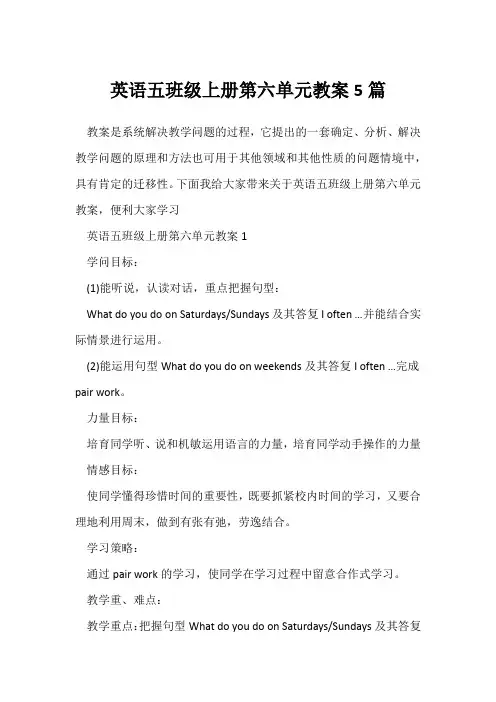
英语五班级上册第六单元教案5篇教案是系统解决教学问题的过程,它提出的一套确定、分析、解决教学问题的原理和方法也可用于其他领域和其他性质的问题情境中,具有肯定的迁移性。
下面我给大家带来关于英语五班级上册第六单元教案,便利大家学习英语五班级上册第六单元教案1学问目标:(1)能听说,认读对话,重点把握句型:What do you do on Saturdays/Sundays及其答复I often …并能结合实际情景进行运用。
(2)能运用句型What do you do on weekends及其答复I often …完成pair work。
力量目标:培育同学听、说和机敏运用语言的力量,培育同学动手操作的力量情感目标:使同学懂得珍惜时间的重要性,既要抓紧校内时间的学习,又要合理地利用周末,做到有张有弛,劳逸结合。
学习策略:通过pair work的学习,使同学在学习过程中留意合作式学习。
教学重、难点:教学重点:把握句型What do you do on Saturdays/Sundays及其答复I often …教学难点:能在实际情景中机敏运用上述句型进行交际。
课前预备:①老师预备录音机,动词词组卡片,挂图,表格。
②课前让同学按要求制作表格教学过程:一、warm-up策略一,歌曲,玩耍教学法①Sing a song: My Days of the week②Game: Golden eyes老师出示几张已学过的动词词组卡片。
do home work, read books, playcomputer games, play football, watch TV …让同学快速地看了一遍,要求同学说出所看到的动词词组,谁说得又多又快就为胜者。
(策略分析;利用歌曲,玩耍活泼课堂气氛,使同学的留意力回到课堂,同学情趣大开。
)策略二;语言交际法③GreetingT: What day is it todayS: It’s Monday.T: What do you have on MondaysS: I have …T: What do you do on Saturdays/SundaysS: I often …(分析;师生自由沟通,增深师生情感,又为以下的教学内容作好学问的辅垫。
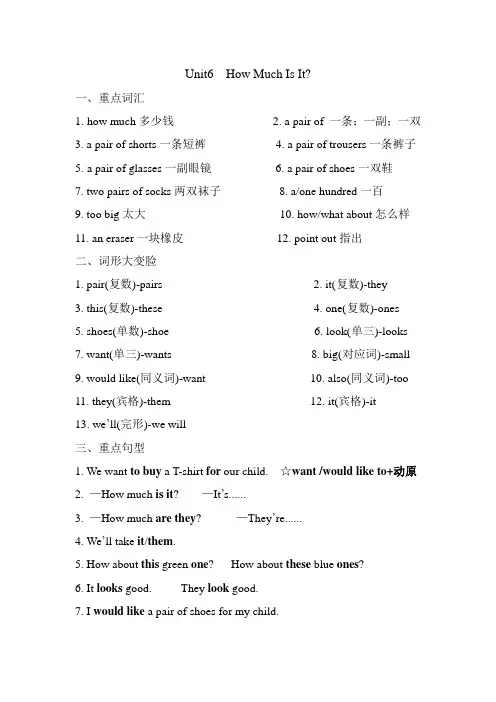
Unit6 How Much Is It?一、重点词汇1.how much多少钱2. a pair of 一条;一副;一双3. a pair of shorts一条短裤4. a pair of trousers一条裤子5.a pair of glasses一副眼镜6. a pair of shoes一双鞋7. two pairs of socks两双袜子8. a/one hundred一百9. too big太大10. how/what about怎么样11. an eraser一块橡皮12. point out指出二、词形大变脸1. pair(复数)-pairs2. it(复数)-they3. this(复数)-these4. one(复数)-ones5. shoes(单数)-shoe6. look(单三)-looks7. want(单三)-wants8. big(对应词)-small9. would like(同义词)-want 10. also(同义词)-too 11. they(宾格)-them 12. it(宾格)-it13. we’ll(完形)-we will三、重点句型1. We want to buy a T-shirt for our child. ☆want /would like to+动原2. —How much is it? —It’s......3. —How much are they? —They’re......4. We’ll take it/them.5. How about this green one? How about these blue ones?6. It looks good. They look good.7. I would like a pair of shoes for my child.8. Here are the hats.9. —Which one do you like?—I like the yellow one.10.I want a pair of shorts.I would like an eraser. ☆would like/want+名词11.How much are the glasses?12.People come to the supermarket to buy food, drinks and clothesafter work.四、句型转换:1.People can buy food, drinks and clothes in the supermarket.(画线提问)What can people buy in the supermarket?2. The shorts are thirty-eight yuan. ( 画线提问)How much are the shorts?3. She is going to buy some bread and cookies. (画线提问)What is she going to buy?4. They are one hundred yuan. (画线提问)How much are they?5. I would like a dress for my daughter. (改为一般疑问句)Would you like a dress for your daughter?6. Do you want to buy a T-shirt? (作肯否定回答)肯:Yes, I do. 否:No, I don’t.7. Does Lily want to buy a T-shirt? (作肯否定回答)肯:Yes, she does.否:No, she doesn’t.。
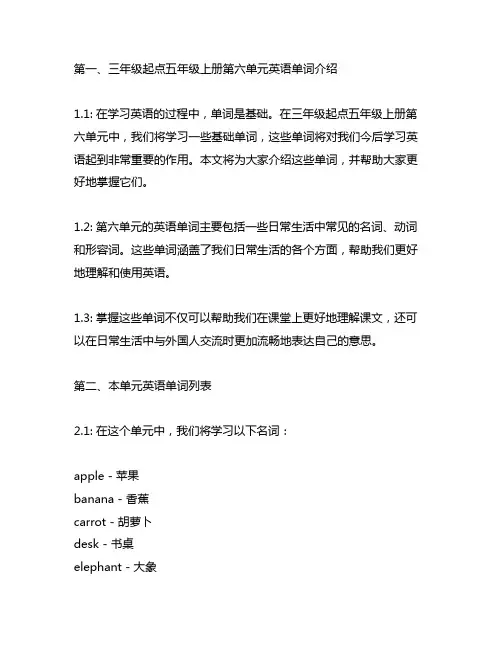
第一、三年级起点五年级上册第六单元英语单词介绍1.1: 在学习英语的过程中,单词是基础。
在三年级起点五年级上册第六单元中,我们将学习一些基础单词,这些单词将对我们今后学习英语起到非常重要的作用。
本文将为大家介绍这些单词,并帮助大家更好地掌握它们。
1.2: 第六单元的英语单词主要包括一些日常生活中常见的名词、动词和形容词。
这些单词涵盖了我们日常生活的各个方面,帮助我们更好地理解和使用英语。
1.3: 掌握这些单词不仅可以帮助我们在课堂上更好地理解课文,还可以在日常生活中与外国人交流时更加流畅地表达自己的意思。
第二、本单元英语单词列表2.1: 在这个单元中,我们将学习以下名词:apple - 苹果banana - 香蕉carrot - 胡萝卜desk - 书桌elephant - 大象2.2: 我们还将学习以下动词:eat - 吃drink - 喝run - 跑jump - 跳swim - 游泳2.3: 我们还将学习以下形容词:big - 大的small - 小的fast - 快的slow - 慢的tall - 高的第三、如何更好地掌握这些单词3.1: 背诵:我们可以通过背诵这些单词,并适当地制定一些背诵计划,比如每天背诵一定数量的单词,逐渐扩大量级,确保自己对这些单词有较为深刻的记忆。
3.2: 练习:我们可以通过做一些练习题来巩固对这些单词的记忆。
可以让家长或者老师出一些练习题,也可以在全球信息站找一些相关的练习题来做。
3.3: 应用:我们可以通过与同学或者老师进行一些口语交流来应用这些单词。
可以做一些针对性的交流练习,提高自己运用这些单词的能力。
第四、总结4.1: 本文介绍了三年级起点五年级上册第六单元的英语单词,并给出了一些建议来帮助大家更好地掌握这些单词。
4.2: 掌握这些单词对我们的英语学习和日常交流都非常重要,希望大家能够认真对待这些单词,通过不断地学习和练习,提高自己的英语水平。
4.3: 希望本文能够对大家有所帮助,祝大家学习进步!考虑到这篇文章的结构和主题,我们可以在续写中增加更多关于这些单词的使用方法和语境,帮助读者更好地理解和运用这些单词。
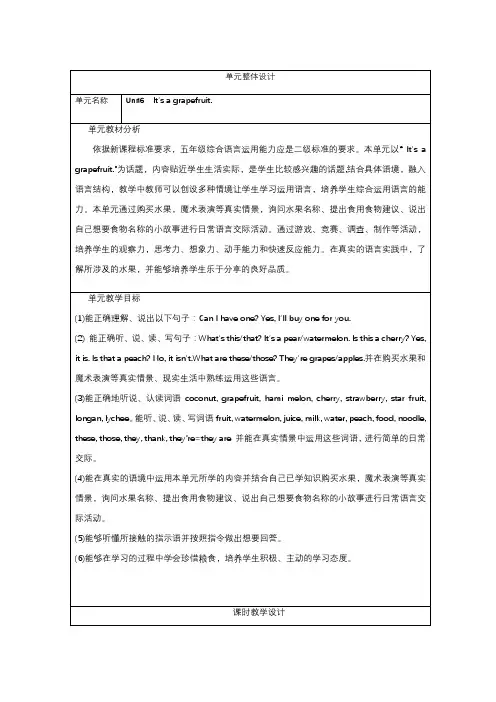
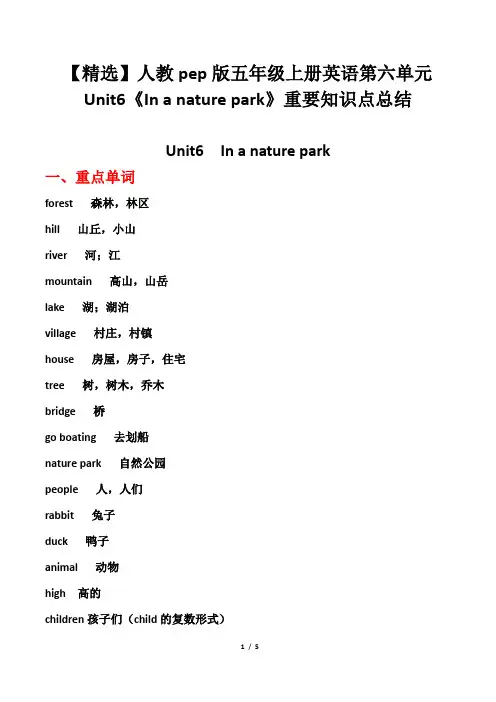
【精选】人教pep版五年级上册英语第六单元Unit6《In a nature park》重要知识点总结Unit6 In a nature park一、重点单词forest 森林,林区hill 山丘,小山river 河;江mountain 高山,山岳lake 湖;湖泊village 村庄,村镇house 房屋,房子,住宅tree 树,树木,乔木bridge 桥go boating 去划船nature park 自然公园people 人,人们rabbit 兔子duck 鸭子animal 动物high 高的children孩子们(child的复数形式)building 建筑物sky 天空cloud 云flower 花grass 草path 路;小道park 公园city 城市road 公路clean干净二、重点句子1. Children, let's go to the forest. 孩子们,让我们去森林吧。
2. —Is there a river in the forest? 森林里有河流吗?—Yes, there is. 是,有的。
/—No, there isn't. 不,没有。
3. The nature park is so quiet! 自然公园这么安静!4.There aren't many people. (这里)人不多。
5.—Are there any tall buildings in the nature park? 自然公园例有高楼吗?—Yes, there are. 是,有的。
/—No, there aren't.不,没有。
6.—How many? 多少?—Two.两个。
7.Robin is at Mr. Jones' house. 罗宾在琼斯先生的房子里。
8.—Where is the ball?球在哪里?—It's in beside/ behind/above/in front of the dog. 它在小狗的旁边/后面/上面/前面。

五年级第六单元复习考点1.自然景观及地点词汇2.There be句型,就近原则There is十单数There are十复数3.There be句型引导的一般疑问句肯定句变为一般疑问句规则及练习一.自然景观及地点词汇森林,林区forest河,江river湖lake高山mountain山丘hill树,树木tree桥bridge建筑物,楼房building村庄village房屋house二.There be句型,就近原则句型There is+a/an+物品(单数)+地点. There are+物品(复数)+地点.翻译:某处有某物1.桌子上有一台电脑。
There is a computer on the desk. 2.自然公园里有一座小山丘。
There is a hill in the nature park. 3.高山的后面有一个湖。
There is a lake behind the mountain.4.村庄里面有一些房子。
There are some houses in the village.5.森林里面有很多树。
There are many trees in the forest.三.There be句型引导的一般疑问句句型翻译:某处有某物吗?问:Is there+单数/不可数名词?答:Yes,there is./No,there isn’t.问:Are there+复数?答:Yes,there are./No,there aren’t.肯定句改为一般疑问句规则:①be动词(is、are)提前②some变成any1.There is a computer on the desk.翻译:桌子上有一个电脑。
改为一般疑问句:Is there a computer on the desk?翻译:桌子上有一个电脑吗?肯定回答:Yes,there is.否定回答:No,there isn’t.2.There is a hill in the nature park.翻译:自然公园里有一个山丘。
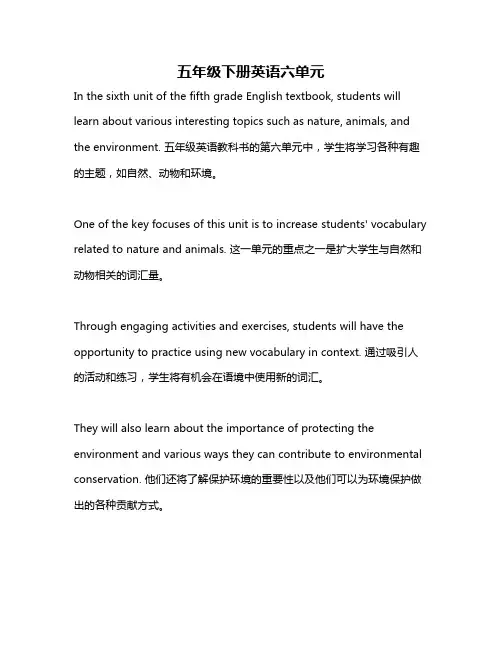
五年级下册英语六单元In the sixth unit of the fifth grade English textbook, students will learn about various interesting topics such as nature, animals, and the environment. 五年级英语教科书的第六单元中,学生将学习各种有趣的主题,如自然、动物和环境。
One of the key focuses of this unit is to increase students' vocabulary related to nature and animals. 这一单元的重点之一是扩大学生与自然和动物相关的词汇量。
Through engaging activities and exercises, students will have the opportunity to practice using new vocabulary in context. 通过吸引人的活动和练习,学生将有机会在语境中使用新的词汇。
They will also learn about the importance of protecting the environment and various ways they can contribute to environmental conservation. 他们还将了解保护环境的重要性以及他们可以为环境保护做出的各种贡献方式。
By discussing topics such as recycling, reducing waste, and conserving energy, students will develop a greater appreciation for the world around them. 通过讨论回收利用、减少浪费和节约能源等话题,学生将更加珍惜他们周围的世界。
五年级上册英语第六单元第二篇课文
五年级上册英语第六单元第二篇课文内容如下:
Miss White: Are you hungry, children?
怀特老师:你们饿了吗,孩子们?
Children: Yes, Miss White. Are there any tables?
孩子们:是的,怀特老师。
有桌子吗?
Miss White: Yes. There are some tables beside the lake.
怀特老师:是的。
在湖边有一些桌子。
Children: Let’s have lunch there, please.
孩子们:请让我们在那里吃午餐吧。
Miss White: OK!
怀特老师:好的!
Zhang Peng: The nature park is so quiet!
张鹏:这个自然公园这么安静!
Miss White: Yes, Zhang Peng. There aren’t many people.怀特老师:是的,张鹏。
没有很多人。
Zhang Peng: Are there any tall buildings in the nature park?张鹏:在自然公园里有高楼吗?
Miss White: No, there aren’t.
怀特老师:不,没有。
Zhang Peng: Are there any animals?
张鹏:有动物吗?
Miss White: Yes, there are. There are ducks and rabbits.怀特老师:是的,有。
有鸭子和兔子。
五年级上册六单元英语
五年级上册第六单元的英语课程通常涵盖了许多基础的语言技能,包括词汇、语法和句型。
以下是一些可能出现在这一单元的英语知识点:
1. 词汇:这个单元可能会介绍一些与学校生活、家庭生活、日常生活等相关的词汇,例如学校用品、家庭成员、日常活动等。
2. 语法:在这个单元中,学生们可能会学习到一些基本的语法知识,例如人称代词(I, you, he, she, they等)、物主代词(my, your, his, her等)、以及一些简单的时态,例如现在进行时(I am doing)和一般现在时(I do)。
3. 句型:学生们可能会学习到一些常用的句型,例如疑问句(Are you doing? What are you doing?)、陈述句(I am doing)以及一些简单的回答方式。
4. 阅读和写作:在这个单元中,学生们可能会进行一些阅读练习,例如阅读短文或故事,并回答问题。
他们也可能会进行一些写作练习,例如写日记或描述日常生活。
以上内容仅供参考,建议查阅五年级上册英语课本或者咨询英语教师,获取更准确具体的信息。
英语五年级上册第六单元一、单词。
1. forest(森林)- 例句:There are many animals in the forest.(森林里有许多动物。
)2. river(河流)- 例句:The river is very long.(这条河流很长。
)3. lake(湖泊)- 例句:We can go boating on the lake.(我们可以在湖泊上划船。
)4. mountain(高山)- 例句:The mountain is very high.(这座山很高。
)5. hill(小山)- 例句:There is a small house on the hill.(小山上有一座小房子。
)6. tree(树)- 例句:The tree is very big.(这棵树很大。
)7. bridge(桥)- 例句:There is a beautiful bridge over the river.(河上有一座美丽的桥。
)8. building(建筑物;大楼)- 例句:There are many tall buildings in the city.(城市里有许多高楼大厦。
)9. village(村庄)- 例句:My grandparents live in a small village.(我的祖父母住在一个小村庄里。
)10. house(房子)- 例句:Our house is near the park.(我们的房子在公园附近。
)二、句型。
1. Is there a …?(有……吗?)- 肯定回答:Yes, there is.(是的,有。
)- 否定回答:No, there isn't.(不,没有。
)- 例句:Is there a river in the park?(公园里有河流吗?)Yes, there is.(是的,有。
)2. Are there any …?(有一些……吗?)- 肯定回答:Yes, there are.(是的,有。
人教版PEP五年级英语上册《Unit6知识点梳理+单元练习》,给孩子收藏学习Unit6知识点梳理一、单词:sky 天空cloud 云mountain 山;山脉river 河流flower 花grass 草lake 湖泊forest 森林path 路;小道park 公园picture 照片village 乡村;村庄city 城市house 房子bridge 桥tree 树road 公路building 建筑物clean 干净的二.句子:1.There is a forest in the nature park.在自然公园里有一个森林。
2. Is there a forest in the park? 公园里面有一个森林吗?------ Yes, there is. 是的,有。
No, there isn’t。
不,没有。
(There be句型的一般疑问句:--- Is / Are there + 某物 + 某地?回答:Yes, there is / are. No, there isn t / aren t. )3. There are many small houses in my village. 在我的村庄里有许多小房子。
4.Are there any pandas in the mountains? 山里有熊猫吗?-----Yes, there are.是的,有/No,therearen’t. 不,没有。
三. 语法:1、There be 的单数形式在变为一般疑问句时,将助动词be提前,与there交换位置,如句中有第一人称代词,变为第二人称,将句末的句号变为问号,其他不变。
第二人称you you you you第三人称he himthey them she herit it人称代词主格作主语,表示动作的发出者。
人称代词宾格作宾语,表示动作行为的对象。
物主代词形容词性物主代词(my/your/his/her/its/our/their)+名词(用于修饰名词)名词性物主代词(mine/yours/his/hers/its/ours/theirs则相当于形容词性物主代词+名词。
Unit 6 In A Nature Park四会单词river 河流 flower 花 grass 草 lake 湖泊 forest 森林path 路 park 公园picture 照片house 房子bridge 桥tree 树road 公路building 建物clean 干净的句型1. The grass is green. 草是绿色的不可数名词2. The clouds play. 云在玩。
可数名词3. There is a river near here. 在这附近有一条河。
在这附近(反义短语:over there)4. There is a nature park in the city. 在这个城市里有一个自然公园。
注意翻译没有生命的东西或者物有什么的时候,必须用there be句型。
5. This is my holiday picture. 这是我的假期照片。
介绍人或物时用this is…句型6. There are many small houses in my village. 在我的村庄里有很多小房子。
注意翻译没有生命的东西或者物有什么的时候,必须用there be句型。
7. Are there any bridges in your village? 在你的村庄里有很多桥吗?肯定回答:Yes, there are. / No, there aren’t.any: 用于否定和疑问句中。
相对应的,many则用于肯定句中。
8. There are no tall buildings. 没有高楼。
此句等于:There aren’t tall buildings.9. I can run on the grass. 我能在草地上跑。
注意on 的用法10. You can see many fish. 你能看到许多鱼。
单复同形:意思是单数复数的形式相同11. What a nice day! 多么好的一天啊!很常用的口语12. Why not? 为什么不呢?很常用的口语,表示很同意对方的说法13. Look! There is a Koala bear over there. 看!在那边有一个考拉熊。
第一部分:单词和短语1. family (n.) 家庭2. have dinner 吃晚饭3. play football 踢足球4. do homework 做家庭作业5. clean the room 打扫房间6. watch TV 看电视7. at home 在家8. on the weekend 在周末9. usually (adv.) 通常10. often (adv.) 经常11. sometimes (adv.) 有时候12. never (adv.) 从不第二部分:语法知识1. 现在进行时:表示正在进行的动作或暂时的情况例如:I am doing my homework now. 我现在正在做我的家庭作业。
2. 表示频率的副词通常用在句子的谓语动词之前,表示动作发生的频率例如:I usually play football with my friends on the weekend.我通常在周末和朋友们踢足球。
3. 介词短语的使用表示时间、地点、方向等概念例如:at home 在家,on the weekend 在周末第三部分:对话A: What do you usually do at home?B: I usually do my homework and help my mom clean the room. A: What about on the weekend?B: I often play football with my friends on the weekend. How about you?A: I never play football. I usually watch TV at home.B: That sounds fun. Do you want to play football with us this weekend?A: Sure, I’d love to!第四部分:阅读理解My FamilyI have a happy family. There are four people in my family -- my father, my mother, my sister, and me. My father is a teacher. He teaches Chinese. He is very kind. My mother is a nurse. She works in a hospital. She is very helpful. My sister is a student. She is in Grade 3. She is very smart. We have dinner together every day. We often play football in the park on the weekend. I love my family. What about your family?第五部分:写作练习以“My Family”为题,写一篇短文描述自己的家庭情况,包括家庭成员的职业、特点、日常活动等内容。